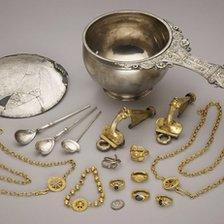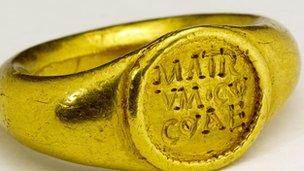Backworth Hoard of Roman treasures home after 200 years
- Published

A hoard of mystery Roman treasures buried near Hadrian's Wall almost 2,000 years ago is back in the area for the first time in 200 years.
Experts believe the haul of gold and silver was buried by a rich man as a thank you offering to goddesses for bringing him good luck in life.
It is believed the haul was unearthed in 1811 in Backworth, North Tyneside.
Now the treasure is back and will be on display at the Segedunum Roman Fort in Wallsend for four months.
In 1850 it was acquired by the British Museum, but by which time the 280 coins from the collection had been lost, apart from one.
'Wealth and power'
Now the treasure is back and will be on display at the Segedunum Roman Fort in Wallsend, North Tyneside, for four months.
The hoard includes a silver pan, mirror, brooches and rings, as well as the solitary coin.
Some of the collection has inscriptions to "mother-goddesses".

It is believed the valuable collection was buried as an offering to goddesses
Geoff Woodward of Tyne and Wear Archives and Museums said: "It's very exciting that these beautiful precious objects are back where they were buried nearly 1900 years ago.
"They are high status objects that demonstrate the wealth and power of an individual living at the eastern end of Hadrian's Wall.
"We believe they were an offering to the gods for something of huge significance that happened in this man's life.
"The mother goddesses represented fertility and life - so he may have been giving thanks for a good crop. All we can do is speculate.
"We would love to trace the other coins from the original 280."
Hadrian's Wall was built in 122 AD on the orders of the Roman emperor Hadrian, and connects Wallsend, near Newcastle, with Bowness-on-Solway on the west coast.
The Backworth Hoard is on display until 15 September.
- Published4 May 2013
- Published21 November 2012
- Published3 April 2013